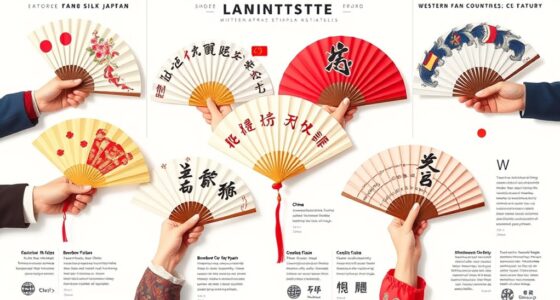Cultural appropriation in chants and banners happens when fans adopt symbols, language, or practices from marginalized cultures without understanding or respecting their true meaning. This can reinforce stereotypes, distort cultural significance, or cause offense. Often, it involves trivializing or misrepresenting traditions, which can lead to hurt, misunderstanding, or alienation. If you keep exploring, you’ll discover how respectful engagement and cultural awareness can help promote more inclusive supporter environments.
Key Takeaways
- Cultural appropriation occurs when fans adopt symbols, language, or practices without understanding or respecting their cultural significance.
- Use of stereotypes in chants and banners reinforces harmful images and misrepresentations of cultures.
- Misusing cultural symbols without context diminishes their meaning and can perpetuate stereotypes and offensive stereotypes.
- Respectful engagement involves learning about cultural origins and seeking permission or collaboration before using symbols.
- Promoting responsible fan practices includes fostering dialogue, cultural education, and celebrating cultures authentically.
Defining Cultural Appropriation in Public Expressions
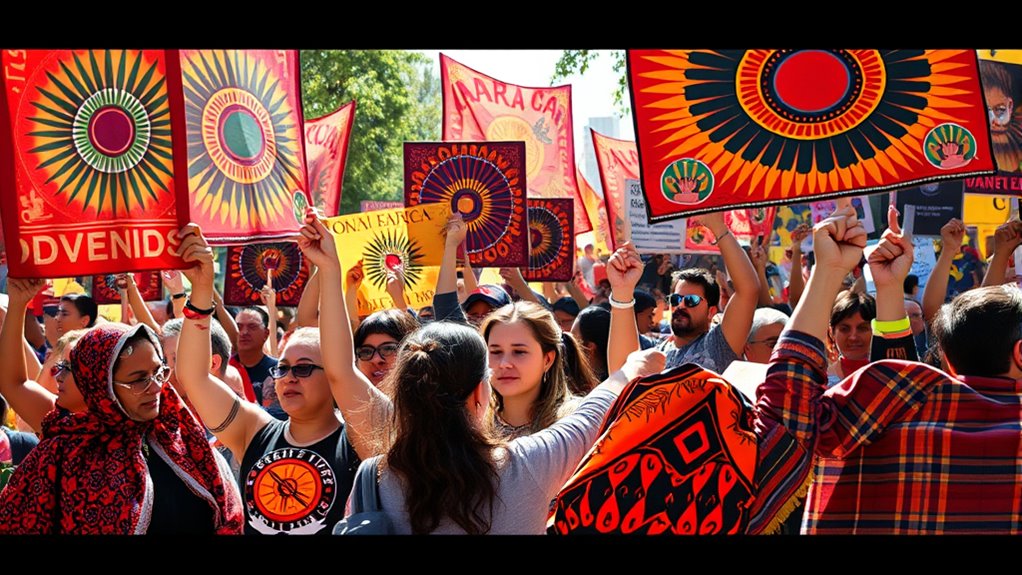
Cultural appropriation in public expressions occurs when individuals or groups adopt elements of another culture—such as symbols, language, or practices—without understanding or respecting their original significance. This often blurs cultural boundaries, making it difficult to distinguish respectful appreciation from cultural insensitivity. In artistic expression, this can manifest as using cultural symbols or phrases without context, reducing them to mere decorations or trends. When you participate in chants or display banners that incorporate cultural elements, it’s essential to contemplate whether you’re honoring the original meaning or appropriating it. Respectful engagement involves understanding the cultural significance behind these elements and avoiding actions that may trivialize or distort their true value. Recognizing these boundaries helps promote genuine appreciation rather than cultural misstep. Additionally, the emotional impact of music and visual symbols can deepen cultural misunderstandings if not approached thoughtfully.
Historical Examples of Cultural Missteps in Supporter Chants
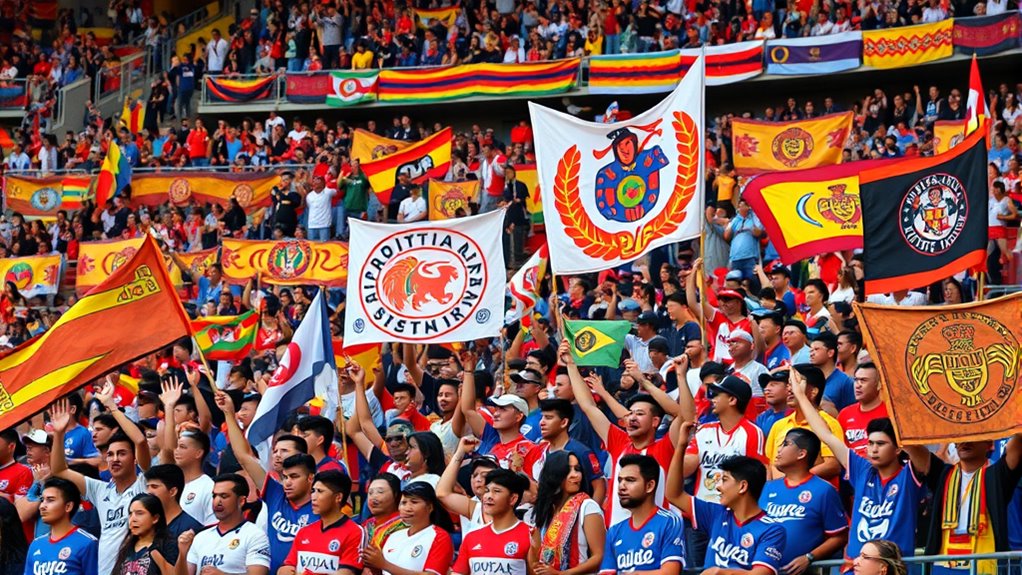
Throughout history, many supporter chants have unintentionally crossed the line into cultural insensitivity by appropriating symbols, language, or practices from marginalized groups. These incidents often stem from cultural miscommunication, where fans adopt elements without understanding their significance. For example, using indigenous words or imagery as rallying cries can reinforce stereotypes, perpetuating harmful ideas about those communities. Such missteps not only offend but also diminish the cultural value of the symbols they mimic. When fans adopt cultural expressions without context, it risks trivializing real struggles and histories. Recognizing how cultural symbols are used in different contexts helps prevent misappropriation and promotes respectful engagement with diverse cultures. These examples highlight how easily well-meaning enthusiasm can turn into cultural appropriation, emphasizing the importance of respecting cultural origins and avoiding stereotype reinforcement in supporter chants.
The Impact of Stereotypes and Misrepresentation

When supporter chants incorporate stereotypes or misrepresentations, they reinforce harmful images that shape public perception. Cultural stereotypes simplify complex cultures into caricatures, often perpetuating false ideas. This misrepresentation can lead to negative consequences, such as reinforcing prejudice or fueling misunderstandings. When you use chants that rely on these stereotypes, you contribute to a cycle where inaccurate ideas become accepted as truth. The misrepresentation consequences extend beyond the game, impacting how others view entire communities. It can cause feelings of disrespect and marginalization among those whose cultures are misrepresented. Recognizing the impact of stereotypes in chants helps you see how words and images can harm, emphasizing the importance of promoting respectful, accurate representations of cultures in supporter expressions. Additionally, understanding symptoms of breast cancer can aid in early detection and potentially save lives.
Recognizing Cultural Symbols and Their Significance
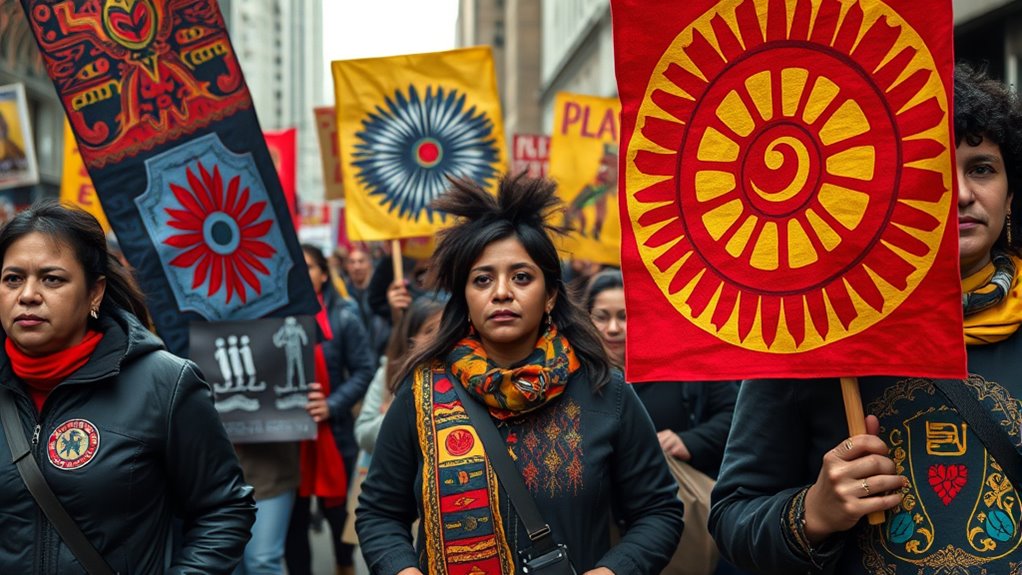
To respectfully engage with cultural symbols, you need to understand their origins and meanings within traditions. Recognizing their significance helps guarantee you represent cultures accurately and thoughtfully. By doing so, you honor the traditions and avoid unintentional disrespect.
Cultural Symbols’ Origins
Understanding the origins of cultural symbols is essential because it helps you recognize their true significance and respect their roots. Knowing the symbol origins reveals how these images or gestures hold deep cultural significance, often linked to history, beliefs, or traditions. When you learn where a symbol comes from, you avoid misusing or misrepresenting it. For example, a symbol’s cultural significance might be tied to spiritual practices or community identity, which shouldn’t be reduced or distorted. By researching the origins, you gain insight into its true meaning and avoid cultural appropriation. Respecting these roots shows you value the culture’s history and avoid superficial or harmful use of symbols that are meaningful to others. Recognizing symbol origins fosters genuine appreciation rather than cultural insensitivity. Additionally, understanding personality traits can enhance your ability to empathize with diverse cultural perspectives and practices.
Respectful Representation Practices
Recognizing cultural symbols and their significance is essential for respectful representation. By practicing cultural sensitivity, you show respect for the communities behind these symbols and avoid misinterpretation or offense. Respectful engagement involves learning about the history and meaning of symbols before using them in chants or banners. Instead of appropriating, seek permission or collaborate with cultural representatives to ensure accurate and respectful depiction. Be mindful that some symbols hold sacred or traditional value and should not be used casually or decoratively. Your goal should be to honor the origin and significance of these symbols, fostering understanding rather than perpetuating stereotypes. Being informed about the cultural significance of symbols can help prevent unintentional disrespect. Through thoughtful recognition and a respectful approach, you contribute to a more inclusive and considerate environment.
Significance in Traditions
Cultural symbols carry deep significance within their traditions, embodying histories, beliefs, and identities that have been preserved over generations. Recognizing these symbols helps you appreciate their true meaning beyond superficial use. Traditional attire, for example, reflects cultural values and social status, while linguistic expressions capture unique worldviews. When you understand these elements, you respect their importance and avoid misinterpretation. Here’s a simple guide: | Cultural Element | Meaning/Significance | Proper Usage | |——————|———————|————–| | Traditional attire | Identity, heritage | Wear during ceremonies | | Linguistic expressions | Cultural worldview | Use contextually | | Symbols in banners | Community pride | Display respectfully | Engaging with cultural elements thoughtfully ensures that their significance is honored and preserved.

When banners use cultural symbols inappropriately or with offensive messaging, it can quickly cross a line. These missteps often cause hurt and controversy, highlighting how boundaries are ignored or misunderstood. Let’s look at some real examples to understand where and why these lines get crossed. Recognizing cultural sensitivity is essential to prevent such incidents and foster respect during celebrations.
Cultural Symbols Misused
Banners that misuse cultural symbols often cross the line into insensitivity and disrespect, whether intentionally or not. When symbols are taken out of context, it can diminish their significance and perpetuate stereotypes instead of fostering genuine cultural exchange or artistic reinterpretation. You might see banners that:
- Use sacred symbols as mere decoration
- Adopt traditional patterns without understanding their meaning
- Incorporate cultural icons without permission
- Combine symbols inaccurately, distorting their intent
- Fail to acknowledge their significance or origins
Such misuse can trivialize cultures and offend communities. While artistic reinterpretation can celebrate diversity, it’s essential to approach cultural symbols with respect and awareness. Recognizing the difference between appreciation and appropriation helps ensure banners honor the cultures they represent. Additionally, understanding the cultural significance of symbols is crucial to prevent misrepresentation and disrespect.
Offensive Messaging Examples
Numerous real-life examples show how banners with offensive messages can cause harm and ignite controversy. These moments often involve insensitive language or images that disrespect cultures or promote stereotypes. For instance, some banners during music fusion festivals or fashion trend events have crossed the line by trivializing cultural symbols. Such messages can offend communities, perpetuate stereotypes, and spark protests. Below is a table illustrating common offensive messaging examples:
| Situation | Offensive Message | Impact |
|---|---|---|
| Music festivals mixing genres | Using racial slurs or stereotypes in banners | Offends communities, sparks outrage |
| Fashion trend events | Cultural symbols used as costumes or props | Disrespects cultures, causes backlash |
| Sports events involving diverse groups | Banners mocking cultural traditions | Promotes stereotypes, insults fans |
| Cultural parades or celebrations | Inappropriate language targeting cultures | Offends participants, invites protests |
| Social media campaigns | Misappropriated cultural phrases or images | Spreads misinformation, fuels debates |
The Role of Intent Versus Impact

While having good intentions might seem enough to justify a chant or banner, it doesn’t always prevent harm. Your intent evaluation is important, but impact assessment reveals the real effects on marginalized communities. You should recognize that:
- Good intentions don’t erase the offense caused
- Impact can differ from what you expect
- Even well-meaning actions can perpetuate stereotypes
- Impact assessment helps understand actual harm
- Balancing intent with impact fosters respectful communication
- Awareness of social dynamics is essential to prevent unintentional harm
Perspectives From Marginalized Communities

Understanding how marginalized communities experience cultural appropriation requires listening to their voices and perspectives. They often face identity misrepresentation, where their culture is distorted or reduced to stereotypes. Cultural commodification turns their traditions into products for profit, stripping away meaning and significance. This exploitation can cause feelings of disrespect and erasure. To evoke emotion, consider this table:
| Impact on Communities | Personal Feelings |
|---|---|
| Identity misrepresentation | Feeling misunderstood or unseen |
| Cultural commodification | Feeling exploited or devalued |
| Loss of authenticity | Feeling disconnected or alienated |
Additionally, the authenticity of cultural expressions is often compromised, leading to further alienation.
Strategies for Respectful and Inclusive Support
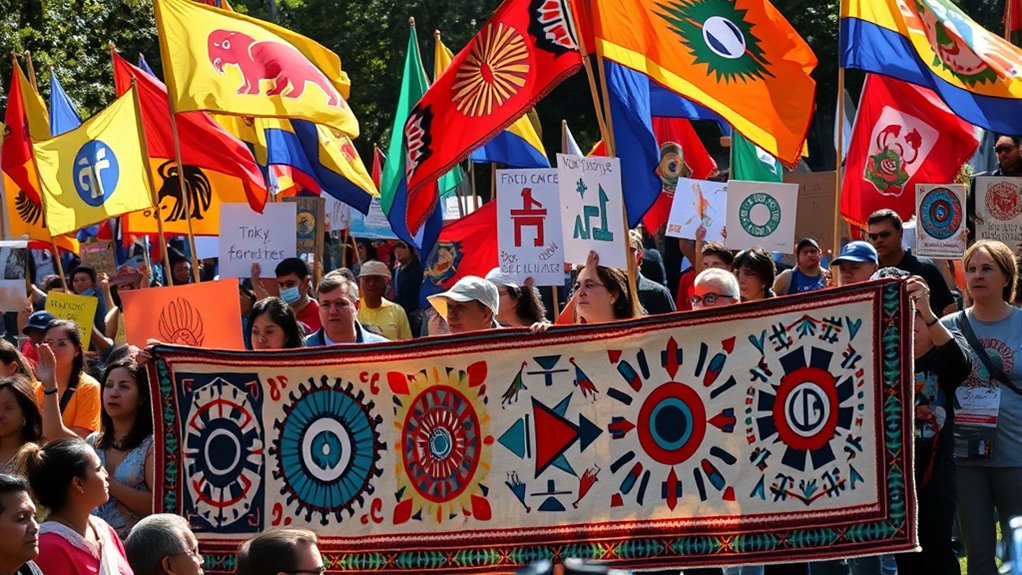
To foster respectful and inclusive support, it’s essential to educate yourself about the cultures involved and listen to marginalized communities’ voices. Practicing cultural sensitivity helps prevent harmful stereotypes and promotes understanding. You can actively contribute by engaging with communities through meaningful dialogue and respectful collaboration. Here are some strategies to contemplate:
Foster understanding by learning about cultures and listening to marginalized voices with respect and sensitivity.
- Learn about cultural histories and significance before participating
- Amplify voices of marginalized groups rather than speaking over them
- Respect symbols, language, and traditions without appropriating
- Support initiatives led by the communities themselves
- Foster open conversations to address concerns and misconceptions
- Be mindful of cultural representation when engaging in chants and banners to ensure respectful expression
Encouraging Cultural Awareness Among Fans and Organizers
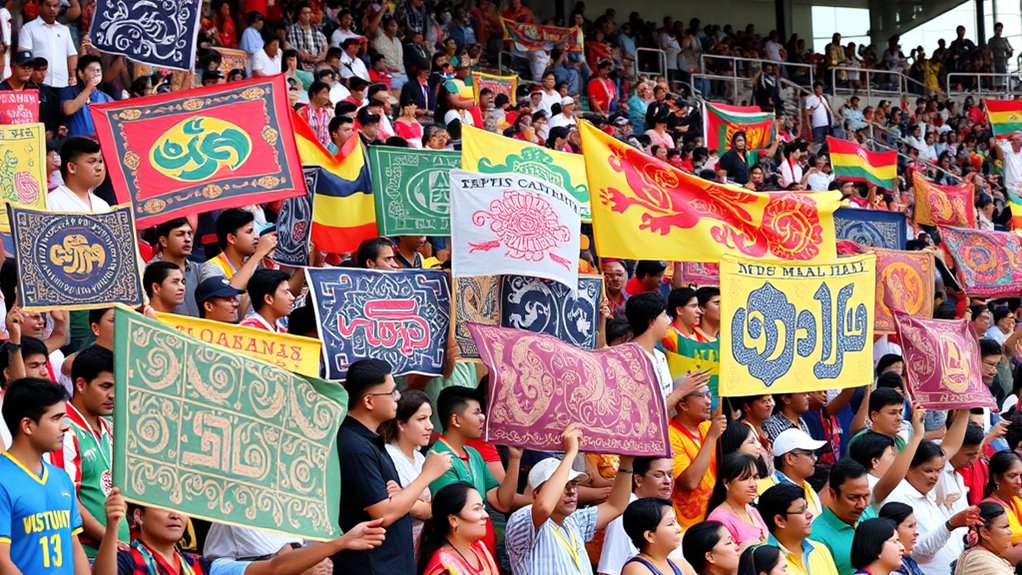
You can help by promoting cultural education among fans and organizers, making them more aware of diverse backgrounds. Encouraging respectful expressions guarantees everyone feels included and valued. When you prioritize understanding and respect, you create a more welcoming environment for all. Incorporating cultural sensitivity training can further enhance awareness and promote positive interactions.
Promote Cultural Education
How can fans and organizers foster a more respectful and inclusive environment? Promoting cultural education is key. You can implement education initiatives that increase cultural sensitivity and awareness. These initiatives might include workshops, informational campaigns, or sharing respectful content before events. Encouraging open dialogue helps attendees understand the significance behind chants and symbols. You should also provide resources that highlight cultural histories and contexts. Additionally, promoting collaborations with cultural representatives ensures accurate and respectful portrayals. Finally, creating clear guidelines about respectful behavior helps set expectations. You should also consider the importance of cultural authenticity when organizing chants and banners, ensuring that expressions are rooted in genuine understanding rather than stereotypes. By actively prioritizing cultural education, you empower fans and organizers to recognize cultural boundaries and reduce the risk of appropriation. This fosters a more inclusive, respectful atmosphere for everyone involved.
Foster Respectful Expressions
Encouraging cultural awareness among fans and organizers requires active engagement and thoughtful communication. You can foster respectful expressions by promoting cultural sensitivity in all interactions. Encourage fans to appreciate different traditions and avoid stereotypes or offensive language. Recognize that artistic expression is powerful but should be inclusive and considerate of diverse backgrounds. Organizers can set clear guidelines that promote respectful chants and banners, emphasizing the importance of honoring cultures without appropriating. By modeling respectful behavior and educating attendees, you help create an environment where everyone feels valued. Incorporating cultural decor elements into event spaces can also enhance understanding and appreciation for diverse traditions. This proactive approach reduces misunderstandings and ensures that cultural expressions enhance the experience rather than cause harm. Ultimately, fostering respectful expressions nurtures unity through genuine appreciation and thoughtful engagement.
Moving Toward Responsible and Celebratory Fan Practices
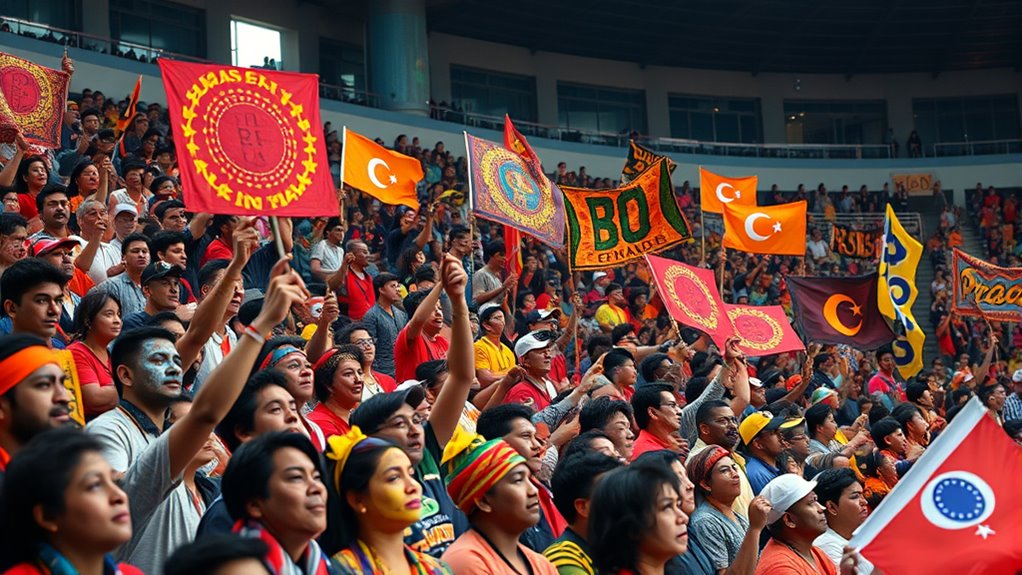
To foster a positive and inclusive atmosphere, fans can adopt practices that celebrate their teams and cultures without crossing boundaries. This requires cultural sensitivity and fan responsibility. You can promote respectful cheering by choosing chants and banners that honor diverse backgrounds. Be mindful of stereotypes or offensive language. Encourage fellow fans to embrace originality and positivity. Support teams through actions that unite rather than divide. Recognize the importance of listening to marginalized voices and learning about different cultures. Respectful celebration helps build a welcoming environment for everyone. Incorporating culturally appropriate expressions in chants and banners can further promote understanding and respect.
Frequently Asked Questions
How Can Fans Educate Themselves About Cultural Symbols Responsibly?
When you want to educate yourself about cultural symbols responsibly, start by seeking out educational resources that promote cultural sensitivity. You can read books, watch documentaries, or listen to voices from the communities involved. Be open-minded and ask questions respectfully. Avoid assumptions and stereotypes. By actively learning and listening, you show respect and help prevent cultural appropriation, fostering a more inclusive and understanding environment.
What Are Practical Steps to Address Cultural Appropriation During Events?
Oh, sure, just wave that banner wildly and ignore the cultural implications—said no one ever. To address cultural appropriation at events, you should foster respectful dialogue and promote cultural sensitivity among fans. Encourage education, listen to voices from those cultures, and set clear guidelines that respect diverse backgrounds. By doing so, you make the environment welcoming rather than appropriative, turning fans into advocates of genuine understanding instead of clueless caricatures.
How Do Legal Considerations Influence the Use of Cultural Imagery?
Legal boundaries considerably influence how you use cultural imagery, ensuring you respect intellectual property and avoid potential lawsuits. You must consider cultural sensitivity, recognizing that certain symbols or images hold deep meaning and should be used thoughtfully. By understanding these legal considerations, you can prevent misappropriation, show respect, and foster inclusivity, creating an environment where cultural expressions are honored rather than exploited or misrepresented.
How Can Organizers Foster Inclusive Environments That Respect All Cultures?
Imagine a vibrant tapestry of colors, voices, and symbols woven together with care. As an organizer, you foster inclusive environments by promoting cultural sensitivity and encouraging respectful dialogue. Create spaces where diverse perspectives are celebrated and shared through inclusive engagement. Listen actively, educate your team, and guarantee everyone feels valued. When you cultivate understanding and respect, you build a community that honors all cultures, making every participant feel seen and appreciated.
What Role Do Social Media Play in Perpetuating or Challenging Cultural Insensitivity?
Social media plays a huge role in shaping perceptions around cultural sensitivity. Viral trends can spread misunderstandings or stereotypes quickly, but online activism also offers a platform to challenge insensitivity and promote respect. You can use social media to call out harmful content or support positive representations. By actively engaging, you help foster awareness and challenge cultural insensitivity, ensuring that digital spaces become more inclusive and respectful for everyone.
Conclusion
By understanding what cultural appropriation truly means, you can help create a more respectful fan environment. Some might think it’s just harmless fun, but your awareness matters. When you choose to celebrate cultures thoughtfully, you show respect and foster inclusivity. It’s not about censorship, but about honoring diversity. So, next time you cheer, ask yourself if your words and banners uplift or marginalize—because your actions can make a real difference.



